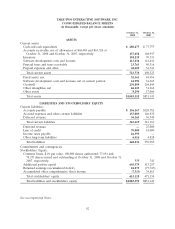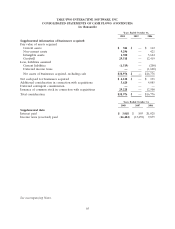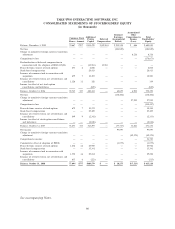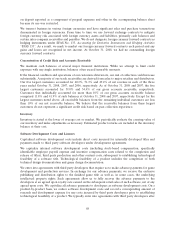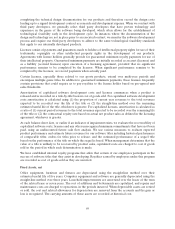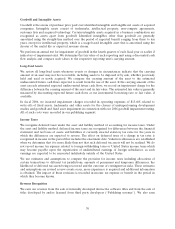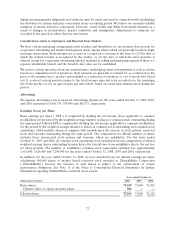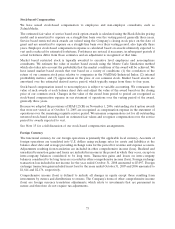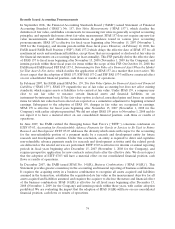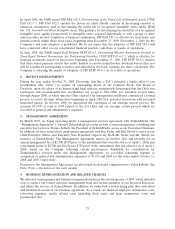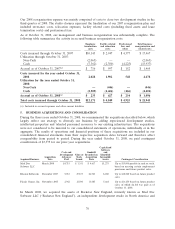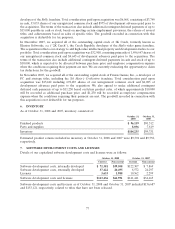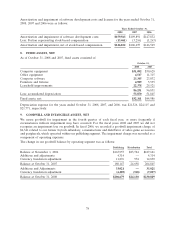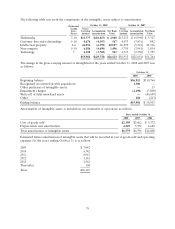2K Sports 2008 Annual Report Download - page 80
Download and view the complete annual report
Please find page 80 of the 2008 2K Sports annual report below. You can navigate through the pages in the report by either clicking on the pages listed below, or by using the keyword search tool below to find specific information within the annual report.Goodwill and Intangible Assets
Goodwill is the excess of purchase price paid over identified intangible and tangible net assets of acquired
companies. Intangible assets consist of trademarks, intellectual property, non-compete agreements,
customer lists and acquired technology. Certain intangible assets acquired in a business combination are
recognized as assets apart from goodwill. Identified intangibles other than goodwill are generally
amortized using the straight-line method over the period of expected benefit ranging from three to ten
years, except for intellectual property, which is a usage-based intangible asset that is amortized using the
shorter of the useful life or expected revenue stream.
We perform an annual test for impairment of goodwill in the fourth quarter of each fiscal year or earlier if
indicators of impairment exist. We determine the fair value of each reporting unit using a discounted cash
flow analysis and compare such values to the respective reporting unit’s carrying amount.
Long-lived Assets
We review all long-lived assets whenever events or changes in circumstances indicate that the carrying
amount of an asset may not be recoverable, including assets to be disposed of by sale, whether previously
held and used or newly acquired. We compare the carrying amount of the asset to the estimated
undiscounted future cash flows expected to result from the use of the asset. If the carrying amount of the
asset exceeds estimated expected undiscounted future cash flows, we record an impairment charge for the
difference between the carrying amount of the asset and its fair value. The estimated fair value is generally
measured by discounting expected future cash flows at our incremental borrowing rate or fair value, if
available.
In fiscal 2006, we incurred impairment charges recorded in operating expenses of $15,608 related to
write-offs of fixed assets, trademarks and other assets for the closure of underperforming development
studios and goodwill and fixed asset impairment in connection with our 2006 goodwill impairment testing.
All of such costs were recorded in our publishing segment.
Income Taxes
We recognize deferred taxes under the asset and liability method of accounting for income taxes. Under
the asset and liability method, deferred income taxes are recognized for differences between the financial
statement and tax bases of assets and liabilities at currently enacted statutory tax rates for the years in
which the differences are expected to reverse. The effect on deferred taxes of a change in tax rates is
recognized in income in the period that includes the enactment date. Valuation allowances are established
when we determine that it is more likely than not that such deferred tax assets will not be realized. We do
not record income tax expense related to foreign withholding taxes or United States income taxes which
may become payable upon the repatriation of undistributed earnings of foreign subsidiaries, as such
earnings are expected to be reinvested indefinitely outside of the United States.
We use estimates and assumptions to compute the provision for income taxes including allocations of
certain transactions to different tax jurisdictions, amounts of permanent and temporary differences, the
likelihood of deferred tax assets being recovered and the outcome of contingent tax risks. These estimates
and assumptions are revised as new events occur, more experience is acquired and additional information
is obtained. The impact of these revisions is recorded in income tax expense or benefit in the period in
which they become known.
Revenue Recognition
We earn our revenue from the sale of internally developed interactive software titles and from the sale of
titles developed by and/or licensed from third party developers (‘‘Publishing revenue’’). We also earn
70




